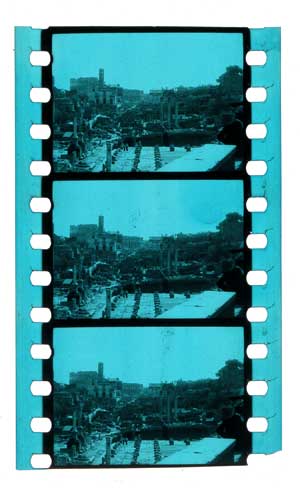|
 |
| |
|
Num. inventario del frammento
Clip inventory number
|
|
1376 |
| |
|
Titolo film
Film title |
|
Fontane di Roma |
Titolo alternativo
Alternate title(s) |
|
Fountains at Rome |
Titolo busta Turconi
Title on Turconi env. |
|
Die Brunnen von Rom |
Casa di produzione
Production co. |
|
Cines |
Nazione
Country |
|
Italy |
Data di uscita
Release date |
|
1912 |
Regia
Director |
|
|
Film conservato c/o
Film preserved at
|
|
BFI; Bologna |
Processi colorazione
Color processes |
|
Altri particolari
Other details
|
|
Scritte sui margini
Edge inscriptions |
|
|
Manifatt. pellicola
Stock manufacturer
|
|
|
| |
|
|
Catalogo Joye n.
Joye Catalogue no.
|
|
1494 |
| |
|
|
Totale frammenti
Total title clips |
|
19 |
Frammento conservato c/o
Fragment preserved at |
|
George Eastman House |
| |
|
|
Num. fotogrammi
Number of frames |
|
3 |
| Note / Notes |
[1494
Die Brunnen von Rom] |
| Commenti, aggiunte e correzioni / Comments, additions and corrections |
PCU, Apr 7, 2011: There is a 1907 Cines film with the same title. However, this print should be from 1912 version, as Joye Collection’s print was 92 meters long, and 1907 version is 60 meters long.
JLY 8/9/2010
Fountains of Rome wouldn’t be the original title for an Cines production. See PCU’s comments below.
MWR 7/28/10
If it has been decided this is a Cines 1912 production, FIAF lists it as Fountains of Rome ( filled it in as original title above) http://fiaf.chadwyck.com.ezp.lib.rochester.edu/fullrec/filmArchivesFullRec.do?id=003/0012701&area=filmArchives&accnumber=13732&resultNum=18&queryId=../session/1280346489_5756&QueryIndex=filmArchives&extra_SOURCE=config.cfg
SBL 3/9/09
FIAF lists production year as 1907
UR, 01/08/2008
I revised the color processes as best I could, but it is tricky indeed to distinguish tones, or partially faded tinting, from decomposition. Especially intriguing in this regard is the top frame of #1390, to which I could not assign any colors. It looks like a brown tone with golden hand coloring or decomposition product - but s Seen with refrelcted light from the base side, the metal salt appears like a copper green!
I agree with Paolo that much of what we see is discoloration rather than tinting / toning.
JLY, 12/27/2007
This title raises a lot of issues, and I remember it fairly well. The colors are quite strange, decomp going on of some sort. Uli, could you check the clippings and see what you can make of the color, particularly in the latter ones, and correct it as you see fit?
If I remember correctly, on the identification, I was working from the updated BFI/Joye records, but as you point out, it’s off, given that it appears to be a “Frankenstein” print. Probably the most interesting example of this in the collection is Title # 0056, “Mosé; Moses,” which contains clips both from the Vitagraph film and a Pathé one. Turconi’s notes on that one indicate that the original print contained both sources, and Bryony has verified that the Joye print at the BFI supports this. Though we have no way of verifying this, it’s possible that this assemblage was the work of Joye.
Regarding how to demarcate cases like this in the database, I would suggest including both titles in the appropriate fields, divided by a color or a slash and then clearly indicate the mixture of clips in the notes field.
PCU, Nov 22, 2007:
Note: As clearly indicated by the different frame lines and camera apertures, the print in question includes sections from two different films:
a) Clips 1-8: Title on print: Das Forum Romanum. Definitely not Fontane di Roma. Something on this title could be found in Herbert Birett’s filmography of films distributed in Germany, in the volume going to 1911. There is a wealth of Italian titles about Rome: Roma antica, Roma pittoresca, etc.; there is no Rovine di Roma as far as I can tell. A comparative analysis of the frame lines might be the only way to identify this one. The frame line and camera aperture seen here do not recall Italian companies, but I may well be mistaken, and it may be possible to solve the question while going through the database. As of now, I am not sure this is an Italian film.
b) Clips 9-19: I’d put [Fontane di Roma] between square brackets in the Alternate Title field, for reference and future identification work. (I think it is very useful to put these archival titles somewhere). This could indeed be a Fontane di Roma, but which version? Itala 1909 or Cines 1912? Frame lines don’t help: they’re not Itala-style, but they are also not Cines, and there is no Cines edge code (though I remember some Cines films without edge code). Ergo: this *may* not be an Italian film at all. Also: some of the clips 9-19 don’t seem tinted and toned to me. Better check the original or a higher resolution picture, but what I see, for instance, in strip 9 *may* indicate just a tinted/toned (or stenciled?) print with some chemical alteration. See, for instance, Strip 17: from what I can see from the scan, the “tinting” seems chemical alteration to me, and maybe the print is just toned (check the original).
By the way, this entry raises the methodological question of how to deal with Turconi items constituted by two or more different titles within the same print. |
|
|





